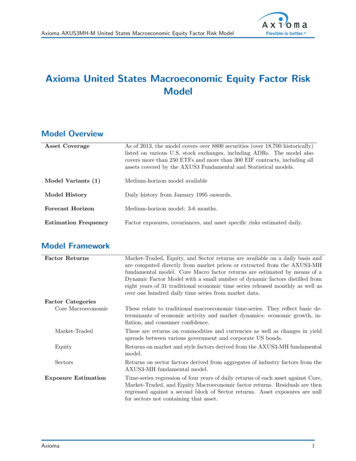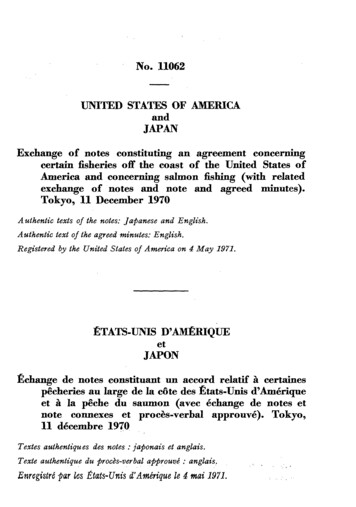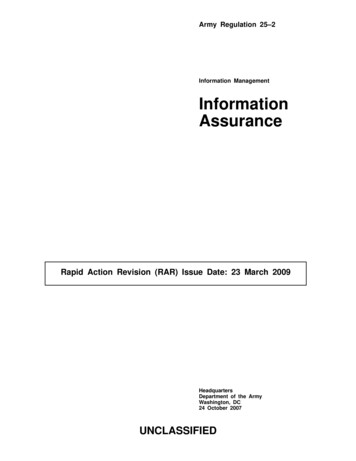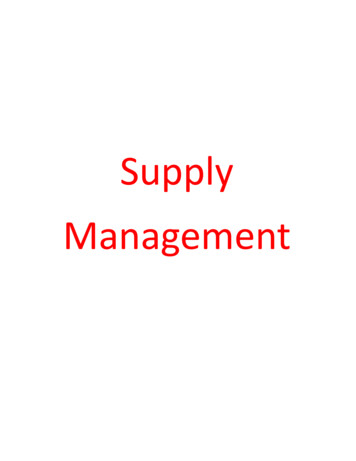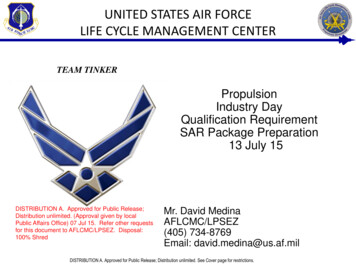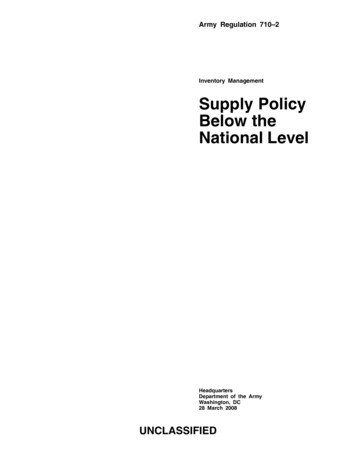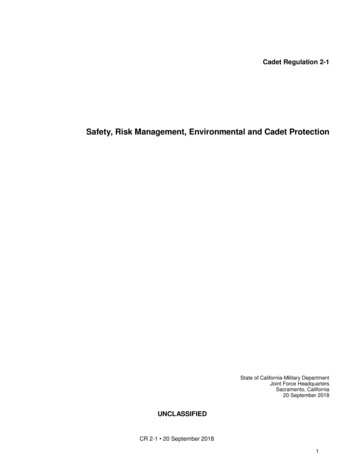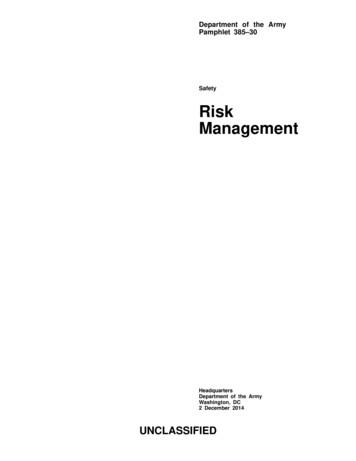
Transcription
Department of the ArmyPamphlet 385–30SafetyRiskManagementHeadquartersDepartment of the ArmyWashington, DC2 December 2014UNCLASSIFIED
SUMMARY of CHANGEDA PAM 385–30Risk ManagementThis major revision, dated 2 December 2014-oClarifies the applicability of this pamphlet (para 1-5).oIntroduces DD Form 2977 (Deliberate Risk Assessment Worksheet) and rescindsDA Form 7566 (Composite Risk Management Worksheet) (now obsolete) (para 1-8).oUpdates and clarifies the requirements and terminology for deviations fromArmy safety standards (paras 1-8e, 4-5, and 4-6).oUpdates table on severity and risk acceptance authority (table 3-2).oClarifies the documentation requirements for risk acceptance (paras 4-5 and4-6).oProvides updated instructions for DA Form 7632 (Deviation Approval and RiskAcceptance Document (DARAD)) (para 4-6 and app C).oProvides appendices containing guidance on the integration of risk managementinto the areas of Army learning and policy systems, sexual harassment andassault prevention, private motor vehicle accident prevention, and suicideprevention (apps D and E).oUpdates definitions in accordance with Army Techniques Publication 5-19(glossary).oIncorporates doctrinal changes in Army Techniques Publication 5-19(throughout).oMakes administrative changes (throughout).
*Department of the ArmyPamphlet 385–30HeadquartersDepartment of the ArmyWashington, DC2 December 2014SafetyRisk ManagementApplicability. This pamphlet applies tothe Active Army, the Army NationalGuard/Army National Guard of the UnitedStates, and the U.S. Army Reserve, unlessotherwise stated.History. This publication is a majorrevision.Summary. This pamphlet provides information needed to carry out policies andprocedures prescribed by AR 385–10. It isdesigned to assist users in implementingand integrating risk management into allphases of the Army operations.ContentsProponent and exception authority.The proponent of this pamphlet is the Director of the Army Staff. The proponenthas the authority to approve exceptions orwaivers to this pamphlet that are consistent with controlling law and regulations.The proponent may delegate this approvalauthority, in writing, to a division chiefwithin the proponent agency or its directreporting unit or field operating agency, inthe grade of colonel or the civilian equivalent. Activities may request a waiver tothis pamphlet by providing justificationthat includes a full analysis of the expected benefits and must include a formalreview by the activity’s senior legal officer. All waiver requests will be endorsedby the commander or senior leader of therequesting activity and forwarded throughtheir higher headquarters to the policyproponent. Refer to AR 25–30 for specificguidance.Suggested improvements. Users areinvited to send comments and suggestedimprovements on DA Form 2028 (Recommended Changes to Publications andBlank Forms) directly to Army Safety Office (DACS–SF), Building 1456, 9351Hall Road, Fort Belvoir, VA 22060–5527.Distribution. This publication is available in electronic media only and is intended for command levels C, D, and Efor the Active Army, the Army NationalGuard/Army National Guard of the UnitedStates, and the U.S. Army Reserve.(Listed by paragraph and page number)Chapter 1Risk Management, page 1Purpose 1–1, page 1References 1–2, page 1Explanation of abbreviations and terms 1–3, page 1Introduction 1–4, page 1Applicability 1–5, page 2The principles of risk management 1–6, page 3Hazard versus risk 1–7, page 3Risk management 1–8, page 3Compliance and risk management 1–9, page 3Chapter 2Step 1 – Identify the Hazards, page 5Introduction 2–1, page 5Defining limits and tasks 2–2, page 5Hazard identification methods and tools 2–3, page 5*This pamphlet supersedes DA Pam 385–30, dated 10 October 2007.DA PAM 385–30 2 December 2014UNCLASSIFIEDi
Contents—ContinuedChapter 3Step 2 – Assess the Hazards, page 6Assessing the hazards 3–1, page 6Definitions 3–2, page 6Probability 3–3, page 6Severity 3–4, page 7Matrices 3–5, page 7Maximum credible risk 3–6, page 8Other matrices. 3–7, page 9Chapter 4Step 3 – Develop Controls and Make Risk Decisions, page 9Develop controls and make risk decisions 4–1, page 9Developing controls 4–2, page 9Residual level of risk 4–3, page 9Making risk decisions 4–4, page 10Deviation documentation and risk acceptance 4–5, page 11Use of DA Form 7632 for documenting deviations and risk acceptance involving ammunition and explosives orchemical agents 4–6, page 11Chapter 5Step 4 – Implement Controls, page 13Implementing controls 5–1, page 13Implementation steps 5–2, page 13Chapter 6Step 5 – Supervise and Evaluate, page 14Supervision and evaluation 6–1, page 14Supervision 6–2, page 14Evaluation 6–3, page 14Feedback 6–4, page 14AppendixesA.References, page 16B.DD Form 2977 Instructions, page 17C.DA Form 7632 Instructions, page 18D.Application of Risk Management to Army Learning Policy and Systems, page 22E.Application of Risk Management to Other Areas, page 26Table ��3.:3–4.:4–1.:4–2.:Risk management probability categories, page 6Risk management severity categories, page 7Standardized Army risk matrix, page 8Risk matrix codes and descriptions, page 8Risk acceptance authority for safety standards deviation, page 11Military–Army civilian equivalent grades, page 11Figure ListFigureFigureFigureFigureii1–1: Holistic approach of risk management, page 21–2: Five-step cycle of risk management, page 4C–1: Example of DA Form 7632 routing, page 22D–1: The analysis, design, development, implementation, and evaluation process, page 24DA PAM 385–30 2 December 2014
Contents—ContinuedFigure D–2: Analysis, design, development, implementation, and evaluation, the military decisionmaking process, andrisk management, page 25Figure E–1: Sexual assault risk reduction, page 27GlossaryDA PAM 385–30 2 December 2014iii
Chapter 1Risk Management1–1. PurposeThis pamphlet establishes a framework for making risk management a routine and required part of planning, preparing,and executing missions and everyday tasks in accordance with Department of Defense Instruction (DODI) 6055.1 andArmy Regulation (AR) 385–10. This framework allows Army leaders to operate with maximum initiative, flexibility,and adaptability. Army operations, whether they involve military situations including tough, realistic training, combatoperations, contingency basing, or the industrial base supporting research, development, testing, and production, aredemanding and complex. They are all inherently dangerous and each has the potential to jeopardize Soldiers and Armycivilians, resulting in the needless loss of limited resources. Managing risks related to such operations requires educatedjudgment, situational knowledge, demonstrated experience, and professional competence. The risk management processenables Army leaders to make informed, conscious decisions to accept risk involving safety and occupational healthand other risk factors. For detailed techniques on implementation of risk management in the operational environment,see Army Techniques Publication (ATP) 5–19. ATP 5–19 provides doctrinal guidance on managing risk within theconduct of operations. This pamphlet and ATP 5–19 are designed to be complimentary, and in tandem, they provideguidance on the implementation of risk management throughout the Army.1–2. ReferencesRequired and related publications and prescribed and referenced forms are listed in appendix A.1–3. Explanation of abbreviations and termsAbbreviations and special terms used in this pamphlet are explained in the glossary.1–4. Introductiona. Unidentified and unmanaged hazards and their associated risks impede successful Army missions, underminereadiness, decrease morale, and deplete resources. The holistic approach of risk management provides commanders atool to recognize, evaluate, eliminate, and control the diverse threats and risks to mission execution. The underlyingphilosophy of risk management is that a loss is a loss. The loss can be any one of the following:(1) Tactical (threat-based) loss.(2) Accidental (hazard-based) loss.(3) Loss due to terrorism, suicide, homicide, illness, or substance abuse.b. Any event that threatens combat readiness and the ability to project power can and should be considered a riskfactor.c. Army leadership and management at every level need to exercise risk management. As shown in figure 1–1, dueto the holistic nature of risk management, the process requires multidisciplinary participation using a range of diversetools to provide the commander with the knowledge to make informed risk decisions about all the identified hazardsand their risk. Losses caused by accidents are a major threat to combat readiness. Practitioners use risk management toidentify, evaluate, and manage risks to missions, personnel, equipment, facilities, and the environment during peacetime, contingency operations, and wartime due to safety and occupational health and other risk factors.d. Risk management provides consistent and systematic identification and communication of risks, consequences,and potential actions to mitigate those risks to the appropriate commander for an acceptance decision.e. Safety standards and policy cannot cover every Army mission and operation. Use of risk management allowscommanders the operational flexibility required to make informed decisions.f. A properly documented risk assessment serves as evidence that command decisionmaking was based on soundjudgment and reasonable principles and aids in defense of negligence claims against the Army by practicing duediligence.DA PAM 385–30 2 December 20141
Legend for Figure 1–1;SA — situational awarenessPPE — personal protective equipmentOPTEMPO — operating tempoFigure 1–1. Holistic approach of risk management1–5. ApplicabilityIn accordance with AR 385–10, Army leaders will integrate risk management into all aspects of military missions andoperations, industrial planning, research and development, systems, equipment, procurement, testing, construction, andprocesses to increase efficiency and effectiveness by eliminating or controlling adverse and risky conditions that willdegrade their execution and value to the Army. Risk management will be applied to Soldiers, Army civilians, and thetotal life cycle of missions, systems, operations, equipment, and facilities, from conception to completion or disposal.a. The basic concepts of risk management apply to all Army operations and functional areas. However, themethodology for evaluating and executing the military decisionmaking process and troop leading procedures has beenestablished under ATP 5–19. Tools and techniques found in this pamphlet are available to support ATP 5–19 analysesand decisionmaking. Guidance for the application of risk management to Army learning systems, leadership, sexualharassment and/or assault prevention, suicide prevention, and private motor vehicle (PMV) accident prevention isprovided in appendices E and F of this pamphlet.b. The Army Acquisition Community risk assessment and acceptance processes are contained in AR 70–1, MilitaryStandard (MIL–STD)-882, and Department of the Army Pamphlet (DA Pam) 385–16. The Army has establishedseveral weapon system related safety review boards, such as the Army Weapon System Safety Review Board(AWSSRB), the Army Fuze Safety Review Board, the Ignition System Safety Review Board, and the U.S. ArmyAviation and Missile Command Software Safety Review Board, to assist acquisition program managers (PMs) in theevaluation and management of the risks associated with their systems.c. Deviations from range standards and procedures are addressed in AR 385–63 and DA Pam 385–63.2DA PAM 385–30 2 December 2014
d. Facility design and construction will apply the risk management principles contained in DA Pam 385–16.e. AR 95–1 governs flight operations. Commanders will integrate risk management into aviation mission planningand execution at every level. Commanders will establish a training and certification program to ensure standardizationand understanding of the mission approval and risk management for all personnel. Commanders will develop localbriefing checklists and risk assessment worksheets for use in assessing aircrew mission planning and risk. Guidance onrisk management is contained in Technical Circular 3–04.11, Army Doctrine Publication (ADP) 5–0, ATP 5–19, andAR 385–10.f. When Army units, facilities, or operations are tenants on another Service’s or allied nation’s installation or aresubordinate to another Service’s or allied nation’s lead during Joint operations, Army risk management must includeJoint and/or multi-national risk management methodology considerations. Joint operations at non-enduring locationswill use the process and procedures in Chairman of the Joint Chiefs of Staff Instruction (CJCSI) 4360.01 for deviationsfrom ammunition and explosives (AE) or chemical agent safety standards (see para 4–6).1–6. The principles of risk managementThe four principles of risk management are—a. Integrate risk management into all phases of missions and operations.b. Make risk decisions at the appropriate level.c. Accept no unnecessary risk.d. Apply risk management cyclically and continuously.1–7. Hazard versus riska. Hazard is a condition with the potential to cause injury, illness, or death of personnel; damage to or loss ofequipment or property; or mission degradation. Therefore, a hazard can have several possible negative outcomes orlosses (for example, injury, death, damage, mission failure, mission degradation, increased resource(s) expenditures,and adverse public relations).b. Risk is determined after hazards are identified and analyzed and is presented as a combined expression of lossprobability and severity.1–8. Risk managementa. Risk management is the Army’s primary process for assisting organizations and individuals in making infor
to the holistic nature of risk management, the process requires multidisciplinary participation using a range of diverse tools to provide the commander with the knowledge to make informed risk decisions about all the identified hazards and their risk. Losses caused by accidents are a major threat to combat readiness. Practitioners use risk management toFile Size: 1MBPage Count: 41
